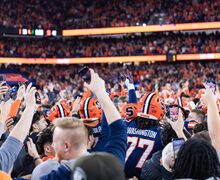Baylee Douglass underwent a new type of UCL surgery this fall
Baylee Douglass stepped into the circle with confidence.
It was Jan. 13, the day before practice officially started for the season and Douglass was throwing her first pitch since November. It had been about 12 weeks since she went under the knife and she was finally cleared to pitch.
Douglass, a senior, injured her right arm before the start of the 2017 season, but tried to fight through the discomfort. After pitching the first two weekends of Syracuse’s (2-1) season last spring, Douglass spent the rest of the spring sitting out, spending eight months figuring out what was wrong. It wasn’t until September that she was diagnosed with a strained UCL. She had surgery in the fall and on Feb. 5, Douglass was fully cleared to compete.
“We’re trying to give her the opportunity to have some good practices prior to throwing her in a game,” Syracuse head coach Mike Bosch said. “We’ll see how her practices go this week and hopefully they’ll be good and we’ll look forward to the weekend.”
It was during a scrimmage at practice on Feb. 4, 2017, that Douglass strained her elbow. She threw a curveball like the hundreds of spinners she’d thrown before. Despite not feeling any pain, she knew something was wrong. The trainer thought it was a muscle strain. Douglass agreed.
At first, Douglass tried rehab and eventually received a cortisone shot, but neither worked. It was time to get more help.
In September, Douglass saw an elbow specialist who diagnosed her with a strained UCL. The UCL (Ulnar Collateral Ligament) connects the humerus and ulna bones in one’s arm, according to hopkinsmedicine.org. Constant, repetitive motion of the UCL can cause a strain or tear, putting pitchers at higher risk of injuring their UCLs.
“It was such a rollercoaster,” Douglass said, “because I was pitching sometimes, I wasn’t pitching sometimes. I got the cortisone shot, I thought it helped. It wore off. It was worse. Then I had surgery.”
Douglass was given several options for recovery, including Tommy John surgery — a common option for UCL injuries. Tommy John is a UCL reconstruction that takes a tendon from another part of the body and moves it to the injured arm to act as a new UCL, according to Johns Hopkins. The 12-plus month recovery time required after the procedure kept Douglass from choosing that path. Instead, she opted for a less-invasive and relatively-new internal brace.
Douglass’ UCL was loose, so the doctors pulled it tight and used the internal brace — “a really strong suture” — and attached it to the humerus and ulna, she said. The surgery is new, Douglass called it “experimental,” and has become an option over the total elbow reconstruction Tommy John surgery requires.
“(The doctor) kind of called it like a piece of tape on my UCL,” Douglass said.
Using platelet-rich plasma injections was also suggested to Douglass. PRP uses a patient’s blood with a higher platelet concentration than normal to heal ligaments and tendons, according to the American Orthopaedic Foot and Ankle Society.
The injection would offer a shorter recovery time but there was less chance of success. The PRP injection is similar to the cortisone shot Douglass had previously tried.
Douglass rehabbed six days a week. She rebuilt strength in her rotator cuff and her forearm muscles, regaining a full range of motion. Then she worked on grip strength.
“My pinky wasn’t really working correctly,” Douglass said, “and that made it difficult to hold my movement pitches. So we had to kind of get that motion back and get that strength back so that I could do that again.”
Douglass was medically cleared to pitch without limitation a year and a day after straining her UCL. While she received the news before the first game of this season, Douglass hasn’t pitched yet. Both she and Bosch agreed that the best thing to do is ease her back in. Bosch doesn’t quite know what Douglass’ role on the team is going to be post-injury, but he is hoping to have her in the circle soon.
When she’s in the circle, Douglass isn’t going to let the past year affect her. She’s not going to hold back.
“The second I start kind of trying to take it easy or babying it,” Douglass said, “is the second I injure it again because I’m not throwing right.”
Published on February 14, 2018 at 11:37 pm
Contact Kaci: klwasile@syr.edu





